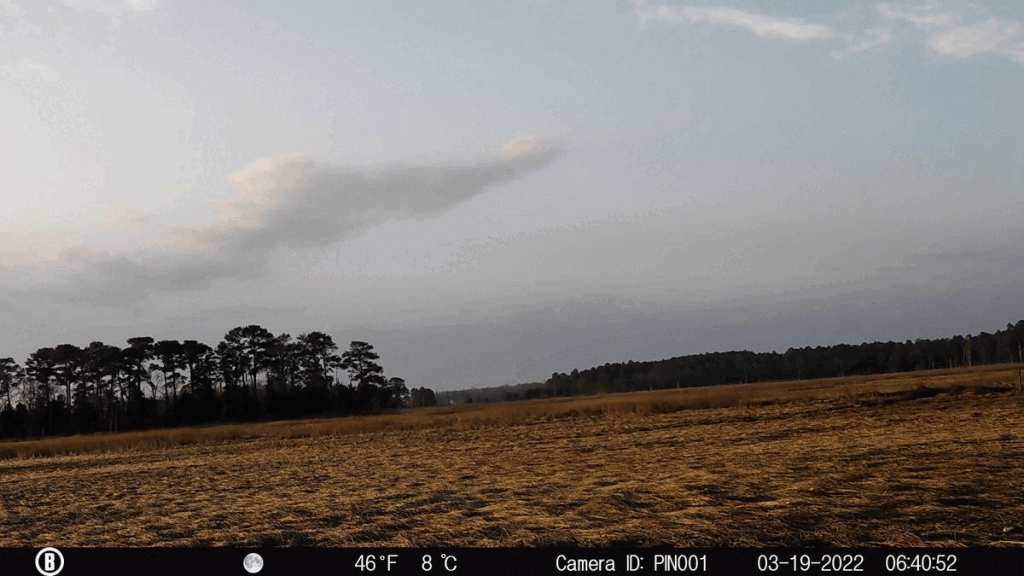
Facebook Twitter Instagram YouTube RSS Feed
Written on: September 26th, 2022 in Wetland Animals
By Kayla Clauson, DNREC’s Watershed Assessment and Management Section
Wildlife cameras are a tool that scientists can use to collect wildlife field data. Discussed previously in a past blog post, wildlife cameras allow scientists to collect field data secretly, without being there, round the clock. This wildlife habitat utilization monitoring is part of a salt marsh recreation project, and supplements other ongoing monitoring that includes nekton sampling, breeding songbird surveys, vegetation, and wetland stability monitoring. Data collection for the project actually takes place within two Delaware salt marshes. One of the sites is where restoration will occur, in which we aim to rebuild a salt marsh where one used to exist. The other site is a healthy marsh and acts as a control. Scientists want to study the changes in habitat and wildlife utilization between both the sites and track any changes that may occur over time at the restoration site.
Each wetland experiences a semidiurnal tide, undergoing two high tides and two low tides daily. The animals that utilize these areas vary depending on time of day as well as the tides. See some differences between high and low tide at both sites below:

Family: Canidae – Fox and Coyote
Although secretive and swift, we’ve captured canids on our wildlife cameras. Canids are mainly nocturnal, and typically are seen during low tides that occur overnight and/or early mornings before sunrise. Two specific canids we’ve witnessed are Eastern Coyote (Canis latrans) and Red Fox (Vulpes vulpes). Because night-time shots are black and white, there are challenges when identifying these animals that have similar features. With assistance from specialized biologists, we were able to identify some of the canids as being the less-common coyotes. Coyotes are only present at our study site. The majority of the canid-captures are red fox. We’ve been fortunate enough to capture persistent interactions between a nesting Canada goose pair and a red fox (If you remember my previous blog post, Honk and Tonk had their work cut out for them defending their nest!). Red fox is present at both salt marshes.
Family: Procyonidae – Raccoon

These furry foragers are seen during similar times as the canids – coming out to eat at night during low tides. Raccoons (Procyon lotor) are omnivorous, eating both plants and animals. They can easily forage for food due to their very functional hands. In the salt marsh they are seen mainly feasting on crabs, shrimp, and fish they catch in the shallow low tide waters. If you observe the pictures closely, you can see how muddy the raccoon gets while walking around foraging in the mud. Raccoon have been seen at both our salt marshes.
Family: Cervidae – White-tailed Deer

Commonly seen on the side of the road grazing on grass, white-tailed deer (Odocoileus virginianus) often frequent the marsh for food. If you are confused how a deer gets to a more remote part of a marsh, you’ll be surprised to know that they are great swimmers! They are indeed very strong swimmers and have been recorded swimming up to 10 miles at a time. Young bucks and females have been spotted on our camera traps, utilizing both of our salt marshes. We were also lucky enough to see a rare piebald deer, with white and brown markings on her body. Piebaldism is a genetic condition that is expressed in about 2% of the white-tailed deer population- a pleasant find on our camera traps!
Family: Cricetidae – Muskrat
A semi-aquatic rodent, the muskrat (Ondatra zibethicus) is often seen swimming or foraging within salt marsh waters. Although muskrat and beaver look similar, live in Delaware, and are both large rodents, they are not closely related. Muskrats are actually in a family with hamsters, voles, mice and rats, not beaver (family Castoridae). Muskrat can be seen at all times of day but have been captured mainly during nighttime.
Family: Mustelidae – Otter

More commonly found in lakes, rivers, and other freshwater wetlands, the North American River Otter (Lontra canadensis) has made an appearance at both of our study sites. There have been a pair of otter swimming and running in our tidal salt marshes. Another mainly nocturnal animal, otter was only captured in night time shots. Since otter are agile on both land and water, they’ve been seen both at high and low tides.
Other Mentions -Turtles and Tides

Although mammals and birds are the targeted species for this monitoring, there are other data that can be utilized from the cameras. For example, we can see the various turtle species enjoying our marshes as well. With the warming weather, turtles such as the diamondback terrapin (Malaclemys terrapin) and the common snapping turtle (Chelydra serpentina) have been spotted more and more frequently basking in the sun or enjoying a swim.

Cameras also provide insight to other important factors, such as vegetation growth, storm occurrences, and tidal range. Observing vegetation is a standard monitoring technique used in our tidal wetland assessments, so capturing photos that show vegetation growth over the year is helpful to gain insight to how the habitat changes. Lastly, we’ve captured the salt marsh providing one of its important ecological functions- by withstanding storms and protecting our uplands from flooding. We’ve captured large waves battering our marshes as well as excess water standing over the marsh following a storm.